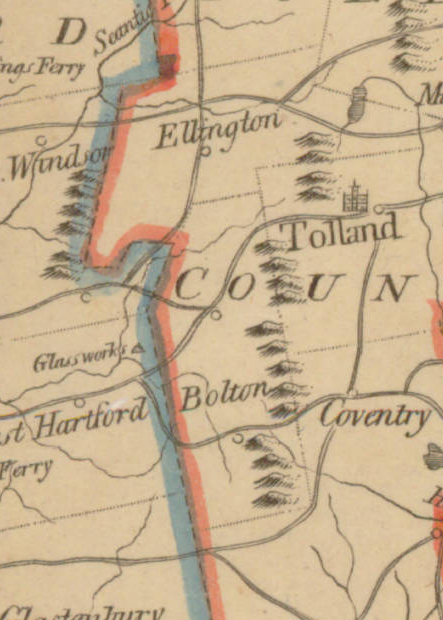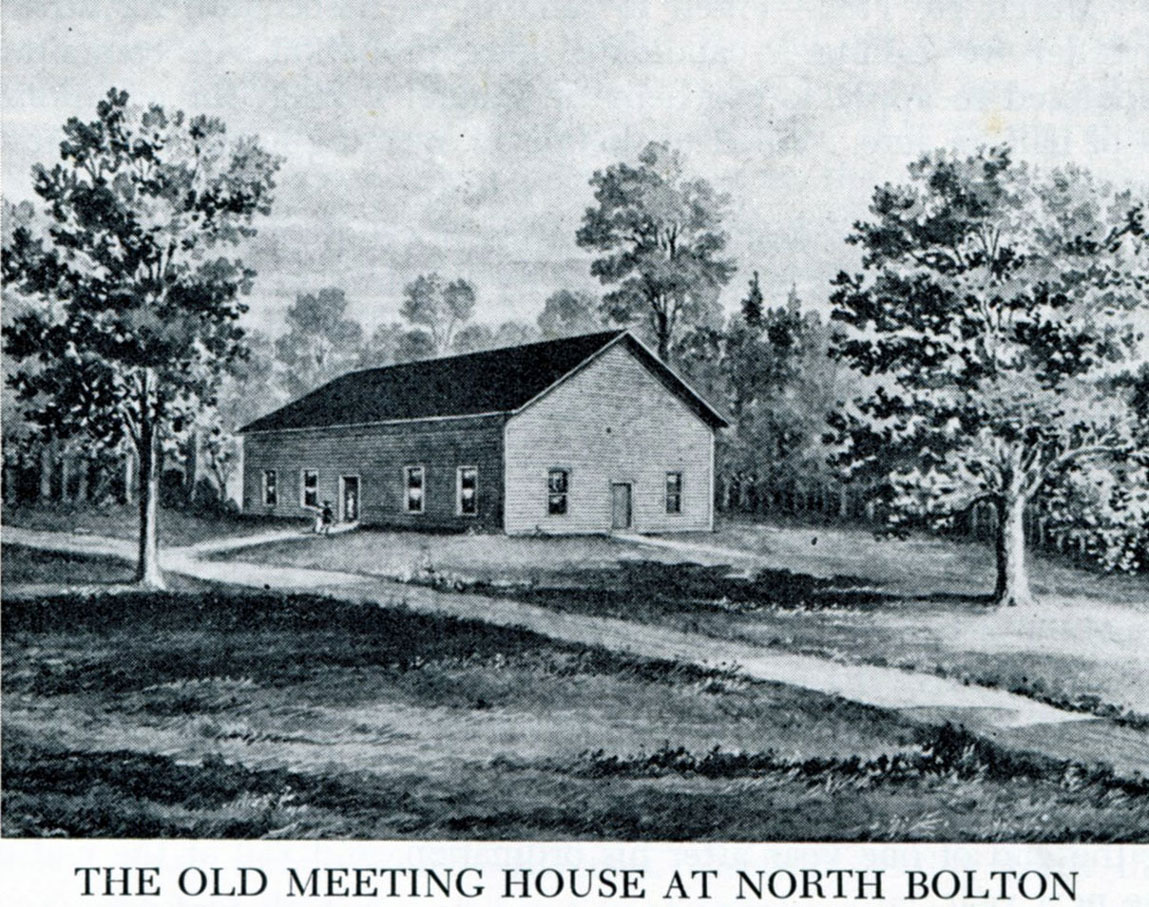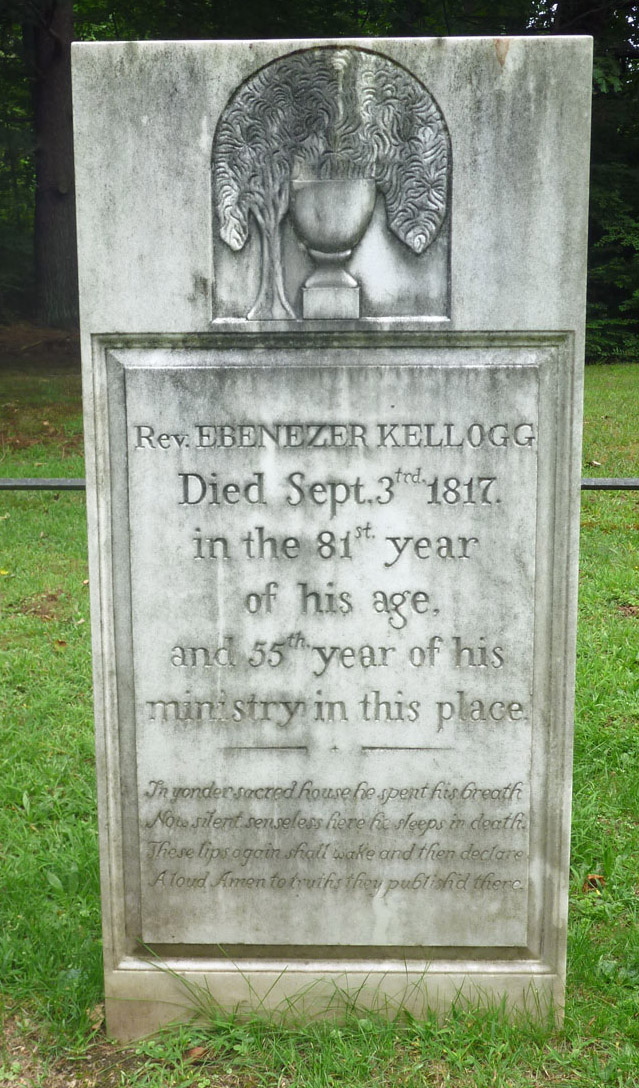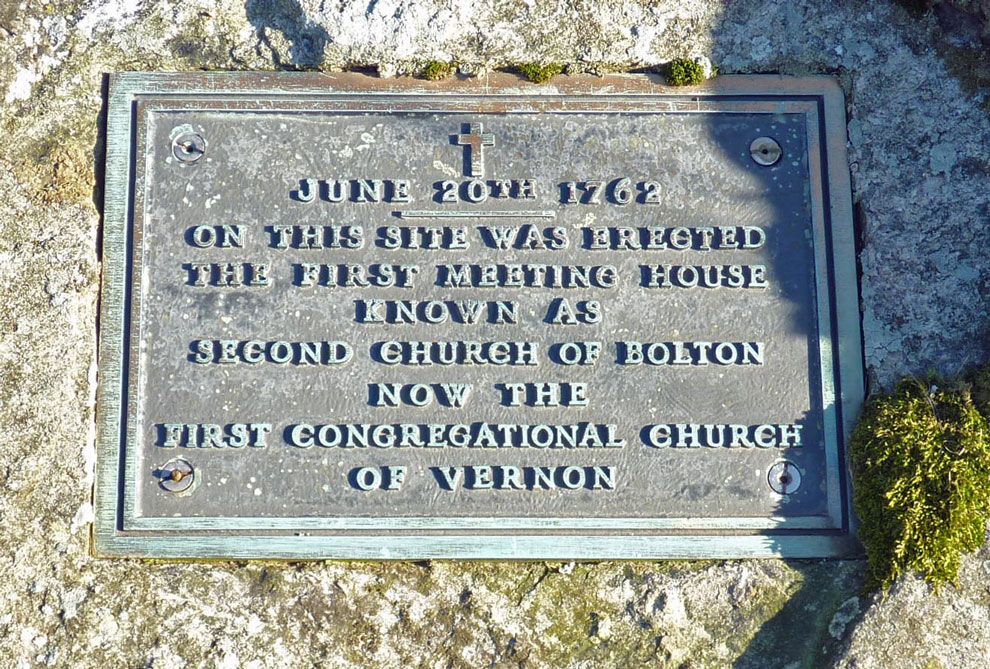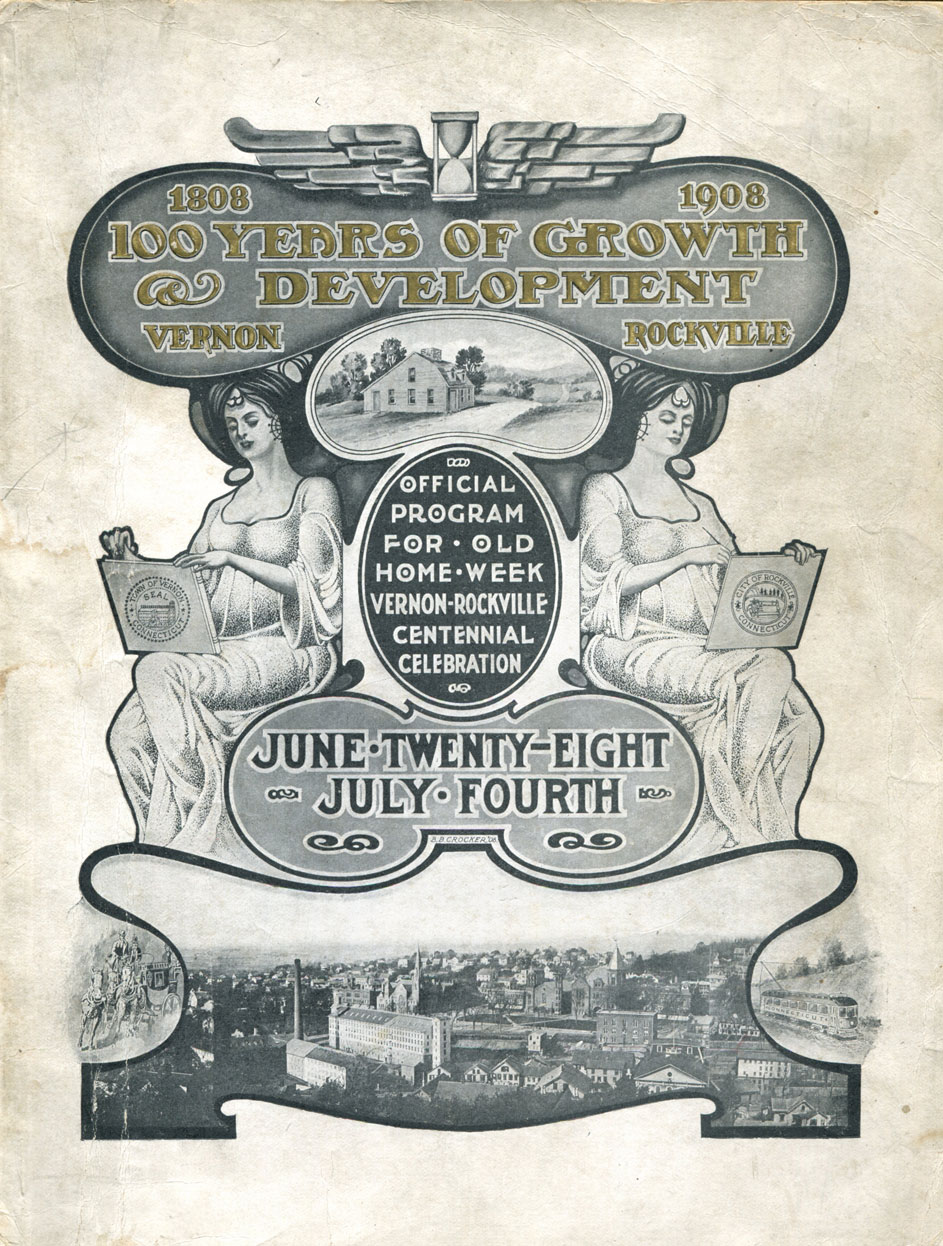 |
| Home | Geography | History | Biology | Recreation | News | Resources |
| Timeline | Narrative | Events | Places | People |
Vernon's First Meetinghouse (1763-1826)Building Vernon's first meetinghouse was an important milestone in the establishment of our town; the first step toward our separation from Bolton. The meetinghouse was where we gathered not only to worship, but to hold town meetings and catch up on news. This is the story of Vernon's first church, or meetinghouse as it was then called, and the role it played in our development. Click on images for full size. Our Earliest History
When Thomas Hooker and his followers passed through Vernon in 1636 on their way to establishing Hartford, Wethersfield and Windsor it was to create a religious colony as they felt it should be; free from the Anglican Church's ritual and hierarchy. Connecticut was founded with a strong connection between faith and government. Congregationalism became Connecticut's official religion and the law required that each town support the public worship of God. When a settlement had enough taxpayers to financially support a meetinghouse and minister it could petition the General Assembly to become an ecclesiastical society. This was the first step to becoming a ?town.' Bolton, which included much of Vernon, was incorporated in 1729 and built their first meetinghouse soon after. Vernon's first permanent settlers came about the same time clearing fields and using the Tankerhoosen River for their saw and grist mills. On Sunday these farmers were required to travel over five miles from Vernon Center to the church in Bolton where they would spend all day and return home late in the day. The routes taken were likely today's Bolton Road which followed the ridge, and today's Tunnel Road and Phoenix Street to Lake Street. The trip could be difficult due to mud, snow and cold, particularly during winter months, as these were not paved roads. North Bolton ParishAs early as 1749 a petition signed by eighteen families from the North part of Bolton was sent to the General Assembly asking that the privilege of a winter parish be granted. It was approved and during the winter meetings were held in schoolhouses and private residences. In 1760, when the population had grown to about sixty families, the Ecclesiastical Society of North Bolton was formed with a territory similar to present day Vernon, but not without resistance from Bolton. It was known as the Second Church of Christ in Bolton until Vernon was incorporated in October 1808. The parishioners immediately went about planning for the meetinghouse.Locating The Meetinghouse
The first meetinghouse was not located where most people might expect it to be. For ease of access the meetinghouse would be located in the center of the community, near a crossroad and preferably on a hill. The site that was chosen, later called Old Meetinghouse Hill, was not at the corner of Center Road and Hartford Turnpike, but a half mile further to the east near the corner of Bamforth and Hartford Turnpike, at the time considered the town center. Recall that the Old Burial Ground of North Bolton was established on Bamforth Road in 1751, ten years before the church was planned. Records and maps of the very early settlement are sketchy but the cemetery would have been near the center of the community, as the Elm Hill Cemetery would be created close to the second church. The 1869 O. W. Gray map shows the area 50 years later. The approximate meetinghouse location (MH) and Old Burial Ground (CEM) are located in red. The David Allis house in 1869 is owned by Deacon Allyn Kellogg, grandson of the first minister and historian. Early services and town meetings were often held at the nearby David Allis house, still located at the corner of Vernon Avenue and Hartford Turnpike, and near to where the first meetinghouse was located. The wooded half acre site was given by the heirs of Samuel Bartlett. The references suggest there was a crossroads here that was later discontinued. There was local opposition to the chosen site which had to be resolved by the County Court. See Notes 1-5 on locating the meetinghouse. Raising The Meetinghouse
Most of the planning meetings were held at David Allis' house. Other familiar names on the committee were John Dart, Aaron Strong, Moses Thrall, Seth King and Titus Olcott. It fronted the highway on the South by one of its longer sides, having doors, also, on the East and West ends. It was larger than the horse sheds and the schoolhouse located nearby. The sides were shingled in chestnut. The meetinghouse was raised on May 6, 1762 and the first worship was held there on June 20. Building the church was probably much like an old fashioned barn raising where the community comes together for a weekend with whole families participating. The church had 35 members who transferred from the church at Bolton. When first used it could have been little more than a shelter for the congregation. Slow progress was made in fitting the building, owing to the slender means of the people. It remained without pews until 1770 and was not plastered until 1774. Until then benches were used. It would take many years to complete. The Meetinghouse"Surrounded by the original forest, which, when summer's sun was high, cast a grateful shade about, it had a stately dignity, in spite of its plainness." Thanks to the town records we have a good idea of what the meetinghouse looked like. It would change and evolve over its 63 year life but this is how it began: "The meetinghouse was 46 by 36 feet, with 22 foot posts. The architecture was typical of country churches with a plain four-sided building without a steeple. The inside was arranged with nearly square pews having straight-backed seats, with galleries on three sides, and, high about the stairs in each front corner, a Negro pew." The pulpit on the north side was elevated and over this a huge sounding board was suspended from the ceiling with a slender rod, which was a source of wonder as well as concern. Rev. Ebenezer Kellogg
On March 29, 1762 they voted to call Rev. Ebenezer Kellogg as their first minister on probation. After a trial period of three months he was hired and remained for 55 years. The Reverend Ebenezer Kellogg was the first pastor of our first Meetinghouse, where he served for 55 years. He was born in Norwalk, CT in 1737, graduated from Yale in 1757 and then studied theology. Kellogg was called to the new parish in North Bolton in 1762 at the age of 25 when the new society had only 35 members. Rev. Kellogg always read his lengthy sermons. They were serious discourses, carefully setting forth the doctrines and duties of religion. The theology of the church was stern in theory and strict in practice. After serving 55 years he died in 1817 at the age of 80 and was buried in the Old Burying Ground on Bamforth Road. Many of his descendants remained in the area as successful farmers, landowners and mill operators. J. R. Cole, writing more than a half-century after Kellogg's death, recognized the enormous influence he had on the town: "The lapse of years since his death has done little to change the social and religious structure of the church and society trained under his efficient ministry. Rarely has any pastor been able so to mold a people into religious faith and action, He was of a sturdy and vigorous mind, Puritan himself, his people became, like him, Puritans." Church LifeThe church was the center of community life in rural New England. Each Sunday farmers would travel from their homesteads to the meetinghouse to worship and to meet their neighbors and ?tell the news.'
"They kept Saturday night then. The moment after sunset was holy time and before that moment arrived all labors must have ceased. A Sunday silence stole over all the village as the last rays of the sinking sun disappeared. Woe to the luckless newcomer who drove out of the village after sundown Saturday night, or who drove into it before sunset Sabbath evening. Before sunset Saturday night the mill was stopped, every room cleared of busy workers and a strange silence reigned where during six days noise was triumphant. None save the watchman's light twinkled from basement to garret in this sacred time; while often a Sabbath evening witnessed a well-lighted room, and busy cloth packers making ready the invoice of goods for the early Monday morning team, market bound. None but church bound wheels or those bearing the physician on his errand of mercy were heard to rumble along the highways to disturb the Sabbath stillness. " (Cole) Tradition says that a tin peddler by the name of Dean, who had been peddling his wares up this way, desired to get to his home in Stafford for over Sunday. Knowing how strict the people were, and with what horror they viewed any desecration of the Sabbath, he ingeniously made a dummy to represent a man from bags which he had in his wagon. When he reached the place where Nathan Lanz now lives he was halted by one of the good fathers of town, who came rushing out of house. With a solemnity that would do justice to a deacon of those days, the tin peddler said: "Keep away, keep away, I've got a smallpox case here." It is needless to say that tin peddler was allowed to go on his way unmolested. The good father of the town who sought to hold him went back to the house quicker than he came out. (Smith) "The peculiar theology and religious character of New England Congregationalism was indelibly stamped upon the men who went from Vernon to Rockville in 1821 to organize its business and plant its institutions. With them the Sabbath commenced with the setting of the sun of Saturday from their recognition of the recorded fact that ?evening and morning made creation's first day.' Even the ?divinity that doth hedge a king' commands hardly more attention than that which was paid to the minister in the early days of the town. The very children were taught to make obeisance to him as they passed along the street. An atmosphere of dignity and solemnity seemed to emanate from his black clothes, high stock and white cravat. Sabbath day was universally honored. Civil guardians restrained out-of-door disturbances of its quiet, and ?tithingmen,' with their long, slender wands gently touching boys or girls, prevented disturbance in the sanctuary." (Smith) Before church on Sundays the young women from the surrounding farms would bring their shoes and stockings, and sometimes their dresses, to a small house on West Road. They would change into their good clothes before they started up the hill to the church, changing again on their return from the afternoon service. (Prescott) Music was also part of the early church. In November 1761 two choristers were chosen, although it isn't clear if they sang as a regular part of worship apart from the congregation or served as song leaders for the hymns. Also early records mention hiring a teacher, a choirmaster and a ?singing school.' In 1818 Connecticut approved a new constitution that disestablished religion and accepted the concept of the separation of church and state. Vernon voted against it. An Era EndsBy the early 1820's the old meetinghouse was no longer adequate for the growing town, and in 1826 a new church was built on the West side of Hartford Turnpike at the corner of Center Road. The original meetinghouse was moved to Rockville in 1831 or 1832 and made the east wing of the old Frank Mill, later known as the Florence Mill. It served as a part of the mill until it was destroyed by fire in 1853. (Prescott, Abbott) Originally a slab, a gift of the heirs of George Maxwell marked the spot where the church stood. In October 1962, on the 200th anniversary of the church, a plaque was placed on Sunnyview Drive at the site of our first Meetinghouse.
In 1908 Vernon celebrated its 100th anniversary. In the official program, page 81 (See Smith) was a lengthy poem by Jans B. Julow on the growth and development of Vernon and Rockville. The ninth stanza reads: "At the beginning when but few, Notes1- "This committee met on the 25th of February, and fixed upon a place on the southward part of land belonging to Mr. Samuel Bartlett, near to the highway that leadeth westward from Mr. David Elis's." (Kellogg) 2- "The site chosen was at the crossing of the highways, long since discontinued, ....... one-half mile east of the present meetinghouse." (Brookes) 3- "It was usual to choose an elevated place for a house of divine worship. This house stood in the most sightly place near the centre of the Society. When first build, it could be reached only from the East and the West, by the highway already mentioned. Several years later, highways were opened leading to it from the North and from the South." (Kellogg) 4- "The meetinghouse stood about half a mile east of the present meetinghouse at Vernon Center, half-way between the Bamforth place, formerly the Hubbard-Kellogg place, and the Charles O. Dart residence, a well known inn during the early days of the town." (Smith) 5- "When I commenced attending Sunday school it was in the old church and school house which stood upon the summit of the hill northeast of where the resent church now stands. The nearest house to the church was Mr. Nelson Skinner's, now Mr. Elam Pearl's. The large chestnut tree now standing near the fence between Mr. H . Kellogg's and Mr. Strong's land is but a few rods from the place where the old sanctuary stood. On the west of the church was a great wood." (From the Tolland County Journal, May 23, 1867 quoting Cole) SourcesEvery book or article written about Vernon has some version of locating and building the first meetinghouse. This article attempts to pull together the various writings from the sources listed. Many of these books can be accessed online; the others can be found at the Vernon Historical Society or the Rockville Public Library.
Abbott, S. Ardis (2003). Building the Loom City - Rockville, Connecticut 1821-1908. Brooks, George S. (1955). Cascades and Courage. 529 pages. This is the classic local history book. The entire text can be found and searched online. Pages 10-12 include sections from the early church records and meetings from 1760 to 1762 detailing the planning of the new meetinghouse. Cole, J. R. (1888). History of Tolland County, Connecticut. 992 pages. Pages 787-788 describe the early meetinghouse. Kellogg, Allyn S. (1888). The Church of Christ In Vernon, Connecticut: An Historical Address. 50 pages. History and memories of the First Congregational Church by Kellogg (1824-1893), grandson of the first minister. Although primarily a church history includes early town history also. Prescott, Celia E. Vernon and Rockville In the Olden Time. - Out of print. Smith, Harry Conklin (1908). A Century Of Vernon, CT 1808-1908. Pages 11-15, 65. Poem 'Vernon' page 81. Prepared and published for Vernon's Centennial. Good history of Vernon's first 100 years drawing on contemporary sources. Smith was the editor of the Rockville Leader. Smith, Harry Conklin (1908). The Connecticut Magazine, Volume 12", 'Centennial of Vernon 1808-1908'. Good history of Vernon's first 100 years drawing on contemporary sources. Smith was the editor of the Rockville Leader. The referenced story is on page 167. This same article was printed in Reference 1. Available at the Connecticut State Library in Hartford. (2002). A History of the First Congregational Church of Vernon - 240th Anniversary. 31 pages. Includes early history of Vernon and first Meetinghouse. Update of 1974 pamphlet. The O. W. Gray 1869 map of Vernon can be accessed from the Connecticut State Library website. Photo 'The Tin Peddler' from "Massachusetts Beautiful" by Wallace Nutting, 1923. |
Home | Activities | News | References | Search | Site Map | Contact Us © Copyright The Tankerhoosen. All rights reserved. |
